SNECMA C.450 Coléoptère French VTOL
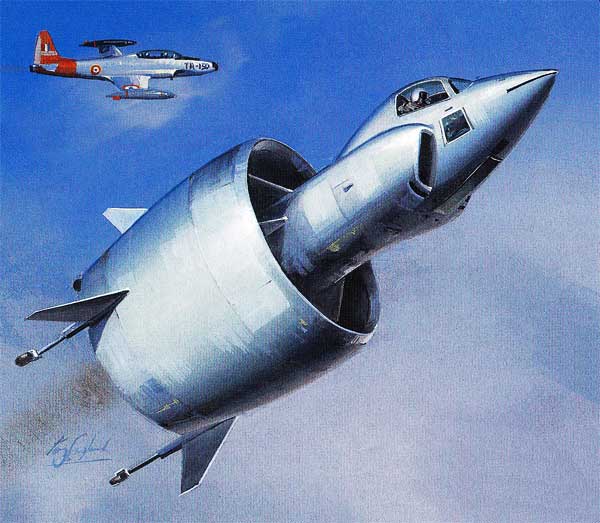
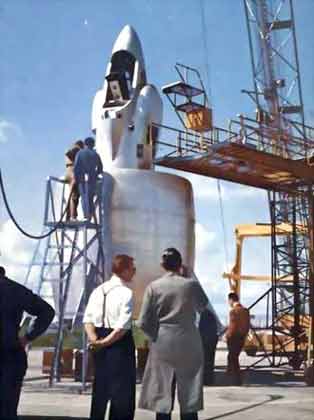
Sitting on an ejection seat attached to the front of a vertically mounted turbojet engine would not be most people's choice of a way to go flying. But that was the formula fro the Atar Volant (flying Atar), a vertical takeoff and landing (VTOL) research aircraft produced by SNECMA in the mid-1950s. By 1959 the basic idea had been developed into the tail-sitting Coléoptère, with an annular wing surrounding the engine.
One of the most extraordinary of the 1950s and 60s vertical take-off (VTO) projects was the French Coléoptère ('annular wing'). Early trials were made with an Atar turbojet mounted in a special test rig, fitted with a four-wheeled undercarriage. After unmanned trials, a piloted version, the Atar Volant, made its first tethered hovering flight on April 8, 1957 , followed by a free flight on May 14. The next step was to enclose the Atar in a fuselage, surrounded by an annular wing to allow the machine to change from vertical to horizontal flight.
More or less normal control surfaces directed the aircraft in horizontal flight and thrust vectoring was used to make maneuvers while vertical. The difficulty with tail-sitting aircraft is landing them, with the pilot looking downwards over his shoulder. Transitioning to and from the horizontal to the vertical is also fraught with danger. So it was on only the Coléoptère's ninth flight, when it failed to hover and began to plummet instead, oscillating about all three axes for good measure. The pilot ejected and the Coléoptère shot off at about 50 degrees before crashing, bringing an end to the program.
SNECMA Coléoptère VTOL
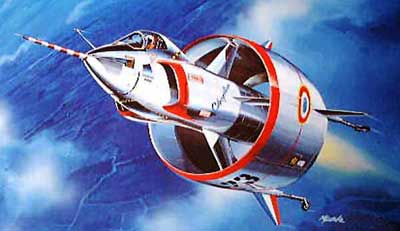
Perhaps the strangest of all the experimental VTOL aircraft to fly was the French SNECMA C.450 Coléoptère.The Coléoptère was a tail-sitting research aircraft, powered by an 81650-pound thrust SNECMA Atar 101EV turbojet installed in the rear fuselage, surrounded by an annular wing with four fins and rudders for directional control.
It followed earlier Atar Volant unmanned and then piloted rigs used for vertical flight trials, and differed principally in having the capability to perform full transitions. The first untethered vertical flight was recorded on May 6, 1959, but the aircraft was lost in an accident on July 25th during a transition flight when it went out of control.
Fortunately, the pilot was able to use his ejection seat to escape. The aircraft had, however, proven the general concept.
Only the other "Tail-Sitter" with reaction to have to fly was due to the combined efforts of a French motor mechanic, the SNECMA, and of a German researcher in France: Mr. Von Zborowski who was devoted to annular wings.
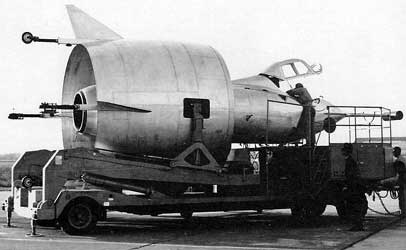
The C-450 was equipped with annular wing with diameter external of 3,20 m and with depth 3 m what gave a really futuristic pace to this apparatus designed in the middle of the Fifties. The fuselage tail section was a simple cylinder containing the engine. The front part contained the cockpit equipped with seat and with orders being able to swivel of 90° during the transitions and significant lower and side surfaces glazed to ensure a good visibility during these phases.
The landing gear quadracycle included/understood legs independent assembled on the annular at the bases of small ailerons. Various systems of detection informed the pilot of the proximity of the ground during the landing with the vertical. Contrary to X-13, C.450 could thus be posed and take off of the ground without special installation as the gantry of X-13 what gave a more realistic apparatus but also more difficult to pose like Convair XFY-1 .
The turbojet was a SNECMA ATAR E-5-v, of 3700 kgp, modified
for a continuous op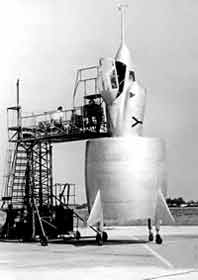 eration in driving position. The side air intake
was drawn especially to ensure a good food in reverse gear and
during the transitions.
eration in driving position. The side air intake
was drawn especially to ensure a good food in reverse gear and
during the transitions.
For the control of the aircraft in fast flight, there were four cast solid control surfaces allowing in-depth aerodynamic control (horizontal control surfaces) or in rolling and direction (vertical control surfaces). For the phases of vertical takeoff and landing, control was ensured by deviation of the jet (pitching and lace) and of compressed air coming from the compressor (rolling).
After a long development in 1958, and testing under gantry, the first coasting flight took place with Villaroche on May 5, 1959. Unfortunately, July 25, during the 7th flight, the pilot had to eject himself because of difficulties to control the apparatus during the descent towards the ground.
All the C-450 program was condemned by this accident and it was vainly that the SNECMA tried to continue this program which however seemed more promising than X-13 from point of view military.
In France, the Société Nationale d'Etude et Construction de Moteurs d'Aviation (SNECMA) began working on a jet powered tail-sitter in 1954. Various rigs were tested from 1955-1957 powered by the 6,400 lb thrust Atar D jet engine, each with increasing complexity. The C450 Coléoptère ("annular wing") was the final step in the program. It had a 22 ft fuselage surrounded by a 10.5 ft diameter annular wing with four small fins above castoring wheels.
The airframe was built by the Nord company. Control in hover was provided by tilting vanes in the nozzle of the 7,700 lb thrust Atar 101E turbojet. In forward flight the small fins deflected the air for control. Two small strakes in the nose could be extended to facilitate a pitch-up moment in transition back to vertical. First tethered hover was on 17 April 1959; first free hover was on 3 May 1959, lasting for 3 1/2 minutes.
The ninth flight was on 25 July 1959; it was to transition to about 36° from the vertical and then return to hover at 2,000 ft before beginning a vertical descent. However, the Coléoptère was unable to establish the hover and began descending faster than desired and fell into oscillations about all three axes. The pilot ejected at 150 ft but was badly hurt. The Coléoptère rotated to about 50° and accelerated horizontally, but did not quite complete the transition and crashed. Emphasis on both sides of the Atlantic changed from dispersal to air superiority and attack, roles for which the tail sitters, with their small payload and range, were ill-suited.
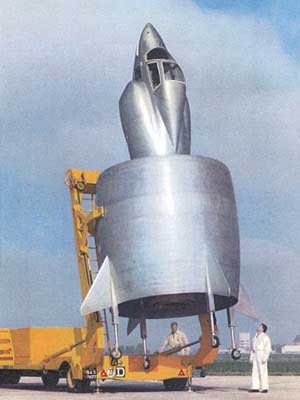
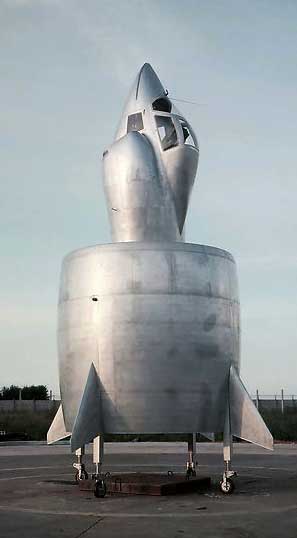
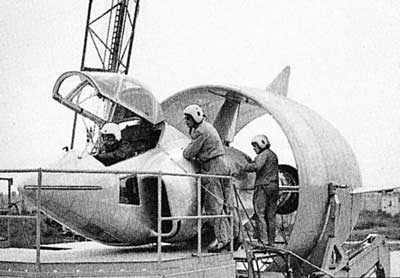
Specifications
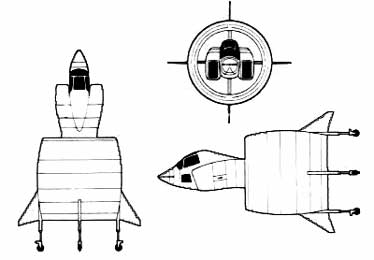 |
Length: 26 ft 4 in |
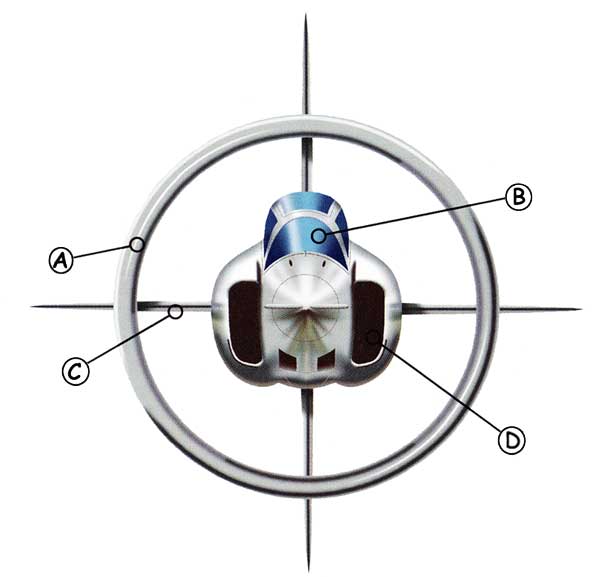 |
|
| A: A head-on view illustrates the perfectly circular wing. In cross-section the wing thickness varied because of its aerofoil shape, This caused a distinctive bulge at mid-chord, giving the Coléoptère its barrel- shaped profile. | B: With its raised and extensively glazed cockpit, the C.450 Coléoptère gave its pilot a good view forwards and to the side. The huge wing would have severely restricted his view rearwards however. |
| C: Cruciform fins mounted on the sides of the mid-fuselage supported the annular wing. They appeared to be pad of the outer fins but were in fact separate items, arranged in a similar cruciform pattern. | D: Large intakes were needed to supply the Coléoptère with sufficient air at low speeds and potentially unusual attitudes. ln general, the engine installation was quite conventional. |
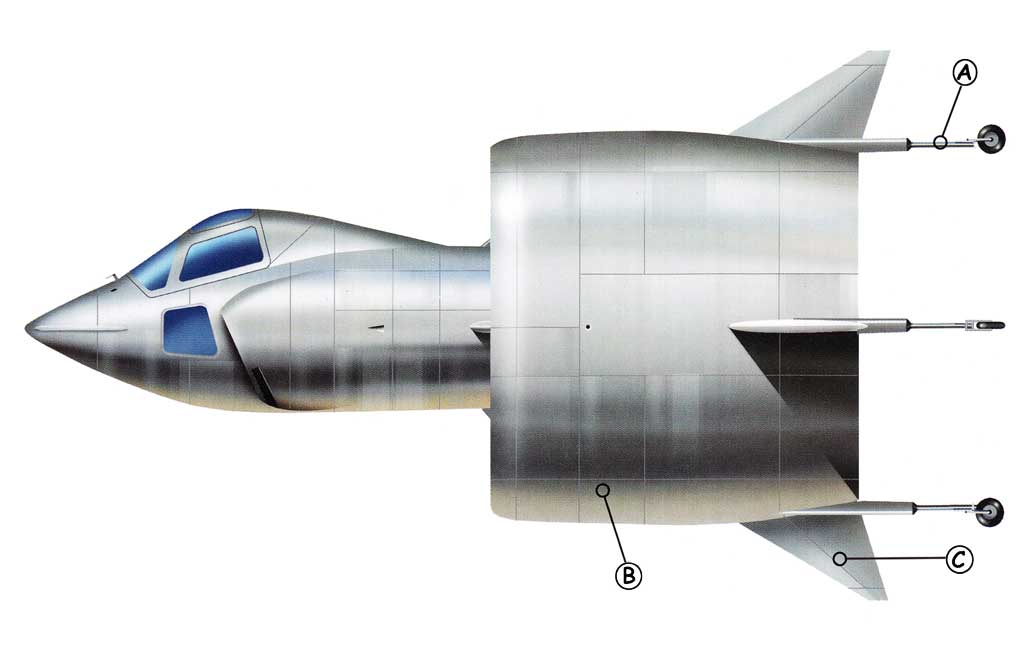 |
||
| A: Had the C.450 Coléoptère been developed into an operational combat aircraft, its weight would have increased considerably, requiring a far more substantial undercarriage. | B: With its ability to provide lift in all directions, the annular wing might have been ideal for VTOL aircraft. | C: Movable fins gave the aircraft directional control in horizontal flight. Both the XFV-1and XFY-1 also featured four fins for stability and directional control. |

